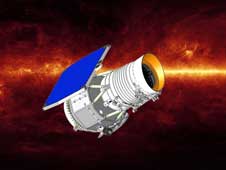
废弃卫星变身小行星探测器
<a href="../201812/t20181229_903800.html">2017年的日全食激发了大众的科学热情</a>(科学60S)
0:00/0:00
最新发布时间:
2014-12-11
Asteroid-Hunting Satellite Returns from Dead
废弃卫星变身小行星探测器
The Wide-Field Infrared Survey Explorer satellite that went into hibernation in 2011 has been brought to life as an asteroid lookout. Clara Moskowitz reports
美国于2011年发射的广角红外巡天探测器起死回生,成为了一枚小行星的监视器。
撰文/播音 克拉拉•莫斯科维茨(Clara Moskowitz)
翻译 李轩
Like a phoenix, NASA's dead WISE satellite has been reborn from its own figurative ashes.
如同凤凰磐涅般,NASA的废弃卫星WISE又重获新生。
WISE was the Wide-field Infrared Survey Explorer. It launched in 2009 to map the universe in infrared light. Unfortunately, it ran out of coolant in 2011 and went into hibernation.
WISE是一个广域红外线巡天探测卫星。它于2009年发射,目的是利用红外线绘制宇宙的地图。但不幸的是,它在2001年耗尽冷却剂,进入了休眠期。
But even without coolant, WISE's infrared eyes are perfect for spotting dim rocks that radiate heat, not light—such as asteroids. Especially asteroids with Earth's name on them.
但即使没有冷却剂,WISE的红外眼依然能敏锐地发现那些发热但不发光的晦暗小行星,尤其是那些对地球人仍然未知的小行星。
So WISE has been resurrected as NEOWISE. Its new prefix refers to near-Earth objects. And the satellite has just filed its first pictures in its new incarnation.
WISE重新投入使用后更名为NEOWISE。新加的前辍是近地物体(near earth object)的简称。这颗卫星刚刚传回了获得新生后拍摄的第一张照片。
If NEOWISE finds potentially dangerous space rocks, we have a chance to try to push them off course.
如果NEOWISE发现有潜在危险的太空岩块,我们就可以试着改变这些石头的飞行轨道。
NEOWISE is also looking for asteroids that astronauts could visit. President Obama wants us to commit to a human visit to an asteroid by 2025. And the repurposing of the satellite could help make reaching an asteroid a bit less of a rocky road.
NEOWISE也在寻找宇航员的登陆目标。奥巴马总统想在2025年实现人类首次登陆小行星,这颗卫星的副加功能可以让我们的登陆过程少一些坎坷。
(题图来源:nasa.gov)
查看更多
©2011- 版权所有:中国数字科技馆
未经书面许可任何人不得复制或镜像
京ICP备11000850号 京公网安备11010502039775号
京公网安备11010502039775号
信息网络传播视听节目许可证0111611号
国家科技基础条件平台
未经书面许可任何人不得复制或镜像
京ICP备11000850号
 京公网安备11010502039775号
京公网安备11010502039775号 信息网络传播视听节目许可证0111611号
国家科技基础条件平台

















